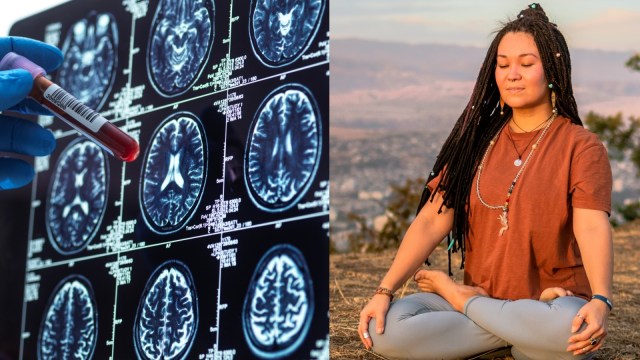📣 For more lifestyle news, click here to join our WhatsApp Channel and also follow us on Instagram
This is what happens inside the human brain before and after Vipassana meditation
Internet users often claim that Vipassana can “rewire the brain,” making a person calmer, more focused, or even fundamentally changing how they respond to stress.
 Regular Vipassana meditation can lead to a reduction in the size and activity of the amygdala, which is associated with fear and anxiety responses
Regular Vipassana meditation can lead to a reduction in the size and activity of the amygdala, which is associated with fear and anxiety responsesVipassana is one of the oldest forms of meditation where a person sits quietly, often cross-legged, and focuses on observing their body, breath, and mind. The goal is to practice mindful awareness by noticing sensations, thoughts, and emotions as they arise without reacting or judging them. The ancient technique is rooted in Buddhist tradition and aims to help one develop clarity, equanimity, and a deep understanding of the mind’s workings.
Internet users often claim that Vipassana can “rewire the brain,” making a person calmer, more focused, or even fundamentally changing how they respond to stress. Numerous studies explore the impact of Vipassana on brain structure and cognitive abilities. One such study from Harvard even found structural differences in the brains of experienced meditators compared to non-meditators.
So, to understand what truly happens in the brain during and after Vipassana practice, we reached out to Dr Bhaskar Shukla, Consultant Neurologist, PSRI Hospital, who helped us break down the science, clarify common misconceptions, and explain what meditation can — and cannot — do for the human brain.
1) What exactly happens in the brain during Vipassana meditation
During Vipassana meditation, the brain undergoes a shift from high activity in the stress and emotional centres to enhanced engagement of areas responsible for attention and awareness, Dr Bhaskar Shukla explains. “This form of meditation trains the mind to observe sensations, thoughts, and emotions without reacting to them.” As a result, activity in the prefrontal cortex (the region linked to focus and decision-making) increases, while activity in the amygdala (the brain’s emotional alarm center) decreases. “The brain moves toward a state of calm alertness, where awareness is heightened but reactivity is reduced,” Dr Shukla asserts.
 Noticeable effects, such as “improved focus and emotional regulation”, can appear within a few weeks of regular practice, typically 20 to 30 minutes daily
Noticeable effects, such as “improved focus and emotional regulation”, can appear within a few weeks of regular practice, typically 20 to 30 minutes daily
2) Is it true that doing Vipassana meditation can alter the brain structure, shrink the amygdala, and strengthen areas linked to focus and self-control
Dr Shukla affirms that scientific studies using brain imaging show structural and functional changes with consistent meditation practice. “Regular Vipassana meditation can lead to a reduction in the size and activity of the amygdala, which is associated with fear and anxiety responses,” he tells indianexpress.com. At the same time, it also strengthens neural connections in regions like the prefrontal cortex and anterior cingulate cortex, which are responsible for attention, emotional regulation, and self-control, he further adds. “These changes help a person remain calm and focused even during stressful situations, reflecting the brain’s remarkable ability to adapt and reorganise itself through experience — a phenomenon known as neuroplasticity,” Dr Shukla asserts.
3) How different are the brain scans of a normal person from someone who performs Vipassana meditation?
According to Dr Shukla, the brain scans of experienced Vipassana practitioners often show increased grey matter density in areas related to attention, sensory awareness, and emotional balance. “In contrast, people who do not meditate may show higher activity in the default mode network — a system linked to mind-wandering and self-referential thinking.” He further explains that in meditators, this network becomes less dominant, allowing for greater presence and reduced rumination. “Functional MRI scans also reveal stronger synchronisation between brain regions involved in attention and compassion in long-term meditators,” he adds.
4) How long does someone need to meditate for such changes to appear — and are these effects permanent?
The extent and permanence of these changes depend on consistency and duration, as per Dr Shukla. Noticeable effects, such as “improved focus and emotional regulation”, can appear within a few weeks of regular practice, typically 20 to 30 minutes daily. “Structural brain changes, however, are usually observed after several months or years of consistent meditation,” Dr Shukla asserts. “If the practice is discontinued, some benefits may fade over time, but many individuals retain improved awareness and stress resilience due to long-term conditioning of neural pathways.”
 Regular Vipassana meditation can lead to a reduction in the size and activity of the amygdala, which is associated with fear and anxiety responses
Regular Vipassana meditation can lead to a reduction in the size and activity of the amygdala, which is associated with fear and anxiety responses
5) From a neurological point of view, what’s the ideal way (duration, frequency) to practice Vipassana for brain health?
Meditating for about 20–45 minutes daily is ideal, Dr Shukla says. Practicing consistently, even for shorter durations, is more effective than occasional long sessions, the neurologist reveals. Morning or early evening, when the mind is quiet, tends to be the best time. “Vipassana should be practiced in a calm setting, with attention to breath and bodily sensations, while maintaining a non-judgmental awareness,” Dr Shukla asserts. “Regular practice helps the brain build resilience and emotional clarity over time,” he adds.
6) Are there any risks or side effects for people who meditate intensively or without guidance?
While Vipassana is generally safe, intensive or prolonged meditation without proper guidance can sometimes bring up suppressed emotions or anxiety in sensitive individuals. Dr Shukla cautions that some people may experience temporary restlessness, emotional sensitivity, or even mild dissociation. “These are not harmful but indicate deep mental processing.” To minmise the risks, he advises beginning under the guidance of trained instructors and progress gradually. “With balance and awareness, Vipassana remains one of the most beneficial practices for long-term neurological and emotional health,” Dr Shukla concludes.
DISCLAIMER: This article is based on information from the public domain and/or the experts we spoke to. Always consult your health practitioner before starting any routine.
📣 For more lifestyle news, click here to join our WhatsApp Channel and also follow us on Instagram


- 01
- 02
- 03
- 04
- 05

























